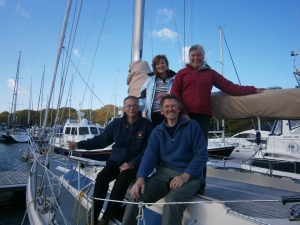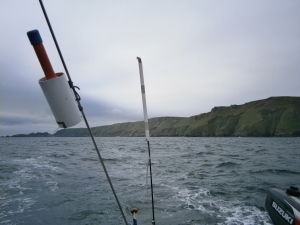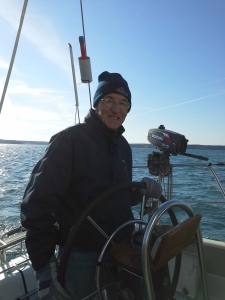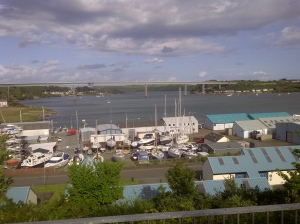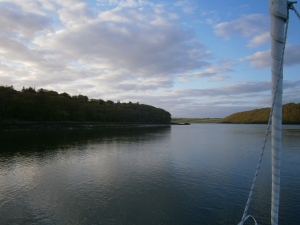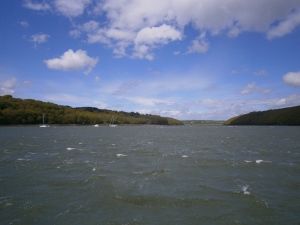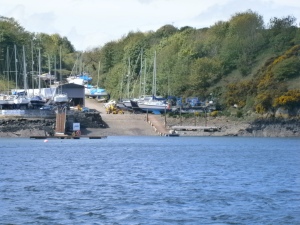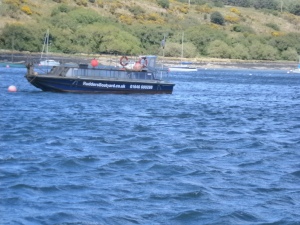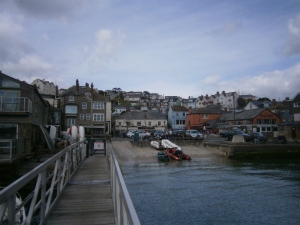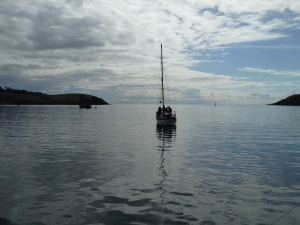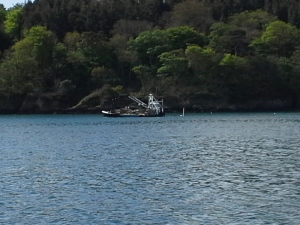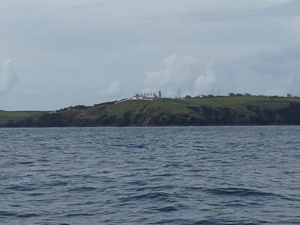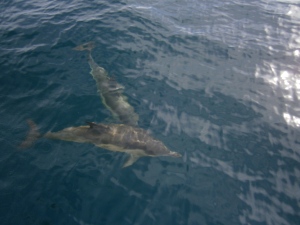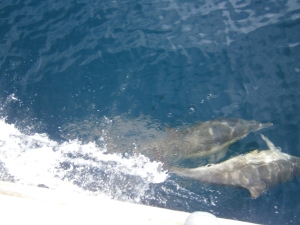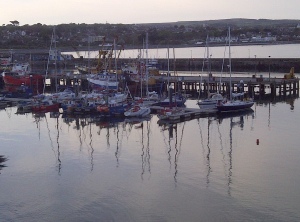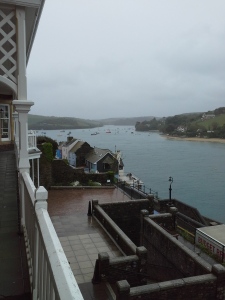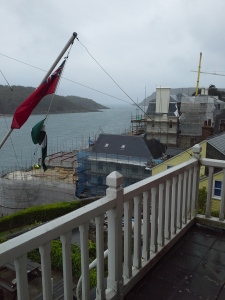Saturday 25th May We awake to a sunny day so all looks good to leave Milford Haven, but not before showering (must get our moneys worth from our marina fees!). We chat to our neighbours on a Warrior (sailing boat) which although old has been done up and looks good so we pick up some tips.
We leave Neyland marina at 1130 and meet up with Karen and Steven

Karen and Steven on their Westerly Merlin “Caliburn”
in their boat Caliburn, a Westerly Merlin, and sail down the entrance to Milford Haven in company with them. We sail past the oil terminals and an old fort before reaching St. Ann’s Head. As we pass Angle lifeboat station we hear a klaxon and see the lifeboat being launched down its slipway – a remarkable sight which we have not seen before. It transpires that a sightseeing boat has hit a rock around Skomer (where we are bound) with 48 people on board so two life boats and a helicopter were scrambled. However, the local dive boat seems to have rescued the passengers whilst the life boats rescued the stricken craft. It made the news we hear!
Karen and Steven sail with us as far as St. Ann’s head to see us safely on our way to Jack’s Sound,

A “Palmerston” Fort: Milford Haven has long been a strategic part of the UK defenses, although less so now.
a narrow strait between Skomer Island and the mainland that has to be negotiated at slack tide.
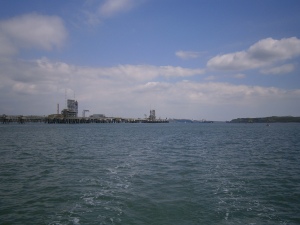
The lower part of Milford Haven – 5 miles of gas and oil terminals to supply a large part of the UK fuel requirements but currently rather quiet
Steven has provided the local knowledge we need and all goes well (thank you Steven!) so we are soon moored in North Haven off Skomer Island. (Anchoring is prohibited due to the eel-grass on the sea bed so the nature conservancy provide free moorings and everyone is happy with that).

Moored in North Haven, Skomer – it could have been the Mediterranean. Bluebells covered the cliffs.
Skomer Island is a wildlife conservation area administered by Wildlife Trust of South and West Wales and is home to a staggering range and number of birds and wildlife – it should be on the “to do” list of every nature lover, especially in late spring when there are hundreds of thousands of breeding birds including puffins, manx shearwater, razor bills, various gulls, fulmars and kittiwakes. Add to that huge areas of wild flowers including bluebells and red campion makes for an extremely rewarding visit, even for people such as us who are not very knowledgeable about wildlife (although our friends are teaching us).
Almost immediately our boat is surrounded by puffins and razor bills whilst large flocks of these birds wheel around the bay. There is a constant procession of birds flying out to sea and back (presumably for food).

Razor bills & puffins swam all around our boat
We cook our selves supper and enjoy the sight and sounds all around us in a calm sunny evening. High on the cliffs we spot a peregrine falcon, a rare sight (unless you live near Derby Cathedral!)
Sunday 26th May.
The following morning we blow up our rubber dinghy and paddle ashore

The ferry from Martins Haven to Skomer. A limit of 250 visitors per day is placed so the island is not overrun.
before the first trip boat arrives. As soon as we land we come across a herring gull sitting on her nest incubating her eggs right by the landing point. The birds generally seem extremely tolerant of humans being very close to them – far more so than would be normal on the mainland. As we climb up the path from the landing we pass a herring gull sitting on her nest.

Herring gull on her nest
The birds on this island seem far more tolerant of humans being very close than is generally the case on the mainland.

Herring gull nest
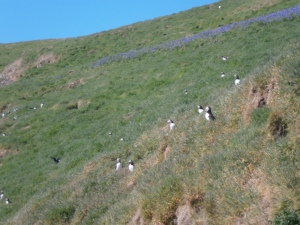
Puffins at their nesting burrows on the cliffs.
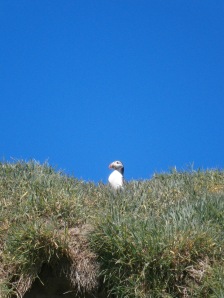 As we climb up the path to pay our £10 landing fee we see puffins poking their heads out of their nesting burrows in the hillside. Puffins seem such dumpy, comical birds but in reality they must be extremely tough as they spend about 10 months out at sea in the North Atlantic, only coming to land to breed in the spring.
As we climb up the path to pay our £10 landing fee we see puffins poking their heads out of their nesting burrows in the hillside. Puffins seem such dumpy, comical birds but in reality they must be extremely tough as they spend about 10 months out at sea in the North Atlantic, only coming to land to breed in the spring.
The island is well laid out with paths plus an information centre so it is relatively easy to walk all around it, seeing the wildlife without disturbing it. That said, there are some areas where puffins have created their nesting burrows right in the path (or did the puffins come first?)
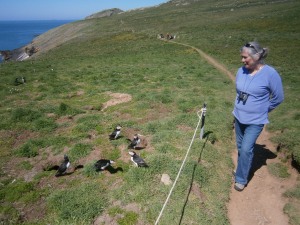
Many of the puffins were amazingly tame and seemed to tolerate humans in close proximity
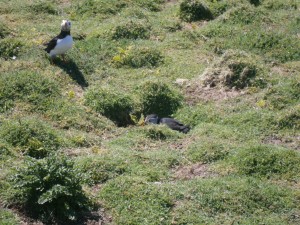

The birds were too busy lining out their nests to take notice of us mere humans
so that it is possible to almost touch them. The birds were busy sorting out their burrows so we were able to take a couple of videos (Puffin City and Puffin sorting his bedding).
On our way round we see huge colonies of fulmars, razor bills, oyster catchers and manx shearwaters plus many other gulls and some land birds (including jackdaws, crows, and a wheat ear.
In between the birds much of the land is carpeted with bluebells and red campion – we have never seen such big areas of these flowers.

The spring flowers were tremendous – blue bells carpeted many of the areas.

Red campion above South Haven, Skomer
In addition to the birds and flowers, we see seals on the rocks, although their time is really September/October when they give birth to their pups on the rocks around the island.
To Fishguard via Ramsey Sound & St. Davids
By early afternoon it is time for us to leave as we have to catch the tide past the next tidal “gate” at Ramsey Island (near St. David’s) on our way north to Fishguard. The dinghy is stored away and we sail north in glorious sunshine over a smooth sea and with a gentle breeze.
(There are many tidal “gates” that we need to pass on our way round the UK. These are usually headlands or straits between islands and the mainland where the tide runs very strongly, making rough water (known as overfalls) which can be dangerous to boats our size. These routes are usually much shorter than going right round the outside of them so the trick is to time the passage at slack water when the tide is turning. Much of the information can be gained from the pilot books and the Reeds Almanac (the yachtsman’s bible) that we have on board but as the tides in these areas don’t always follow the main tides local knowledge is extremely helpful. Steven provided this for us to pass through Jack;’s Strait en route to Skomer whereas the pilot book provided this for Ramsey Sound).
In the event, the passage works out very well. We have a Navionics software package with all the chart details for the British Isles on our Samsung tablet. Although it only cost £45 it is remarkably detailed. It is linked to the GPS in the tablet so we could use it to track our route through the Strait. So far we have found it excellent for this sort of work but we also plot our course on the regular charts using our Yeoman Plotter so we have “belt and braces” through the more awkward channels.
The wind is behind us – too strong to use the spinnaker but we can “goose-wing”with

Goose-winging to Fishguard
one sail out each side of the boat. We make rapid time with the tide behind us, reaching 10.5 knots at one stage as we pass Strumble Head. It’s a great sail. We arrive an hour earlier than planned at Fishguard as the wind strengthens. The weather is forecast to get windy and very wet over the next 36 hours so we anchor in a sheltered spot under the cliffs by old Fishguard to ride out the bad weather alongside some other yachts doing the same thing.
Monday 27th May
It’s a Bank Holiday and in keeping with normal practice the weather is pretty dire – wet and windy –
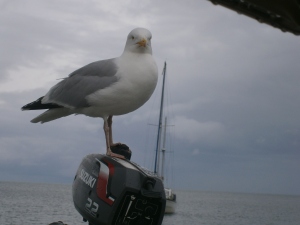
A visitor in soggy Fishguard
so we do jobs in the boat. A solitary seagull visits us and Bob sends us an e mail with a photo of our boat from the road above. We need to get to Aberystwyth tomorrow to meet up with Chris Brown who is sailing with us for a few days but is so wet and windy we decide to stay put, snug & dry and get up early tomorrow to catch the tide north to Aberystwyth.
Tuesday 28th May
Up and off the anchorage at 5 AM (Not our start time of choice but time and tide wait for no-one – or at least the tide doesn’t!) The weather has cleared but there is little wind so we motor sail north, set the autohelm (so the boat steers itself) so we can have breakfast and tidy up. John decides that it is time to brighten up the teak so gets to work with scrubbing brush and teak brightener – a boring job but the boat definitely looks better when all is

Teak brightening the decks at 8AM!
done. We shall try to find some teak sealant suitable for boats on our travels to keep it that way. Yvonne cleans up inside. The sun is shining, the green coast line passes by and we get past Aberporth firing range before the military get up and start asking the few boats around to move away from the firing area out at sea. By the time we are off Aberystwyth at midday the boat is looking a lot better and we are feeling virtuous!
We reach Aberystwyth in time for the high tide (which is needed to get into the harbour). After lunch we visit the local Co-op to re-provision the boat and find that it is now law in Wales to charge 5p for every plastic carrier bag! However, the good news is that the Co-op does local deliveries which includes the harbour at no cost so Yvonne waits at the boat for our groceries whilst John tramps miles to try to find a 12v charger for the laptop as the one we have does not work correctly, meaning that we have to be on shore power to use the computer for any length of time (which is why the blog appears at infrequent intervals). However the local PC World, B & Q, Halfords and caravan shop cannot help so we order one from Amazon (yes, we know they don’t pay proper taxes in the UK but we are desperate) and hope it arrives with John’s daughter Katharine in time for her to bring it to us next week.
Chris arrives but by now the heavens have opened (well it is Wales) so he takes a taxi to us. We decide on an Indian meal out as we have cooked on board for quite a few nights but get very wet en route.
Tomorrow we plan to go north to Porthmadog, but that is another story…
Fair winds to you all
Yvonne, John & Chris

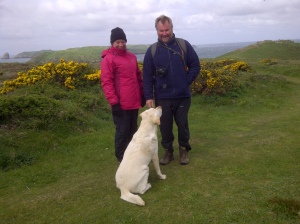
 Melbourne, Bob Belk, has a caravan in Pembrokeshire contacted us to fix up a walk round the headland at Wooltack opposite Skomer as the weather continued to blow old boots from the north.
Melbourne, Bob Belk, has a caravan in Pembrokeshire contacted us to fix up a walk round the headland at Wooltack opposite Skomer as the weather continued to blow old boots from the north.
